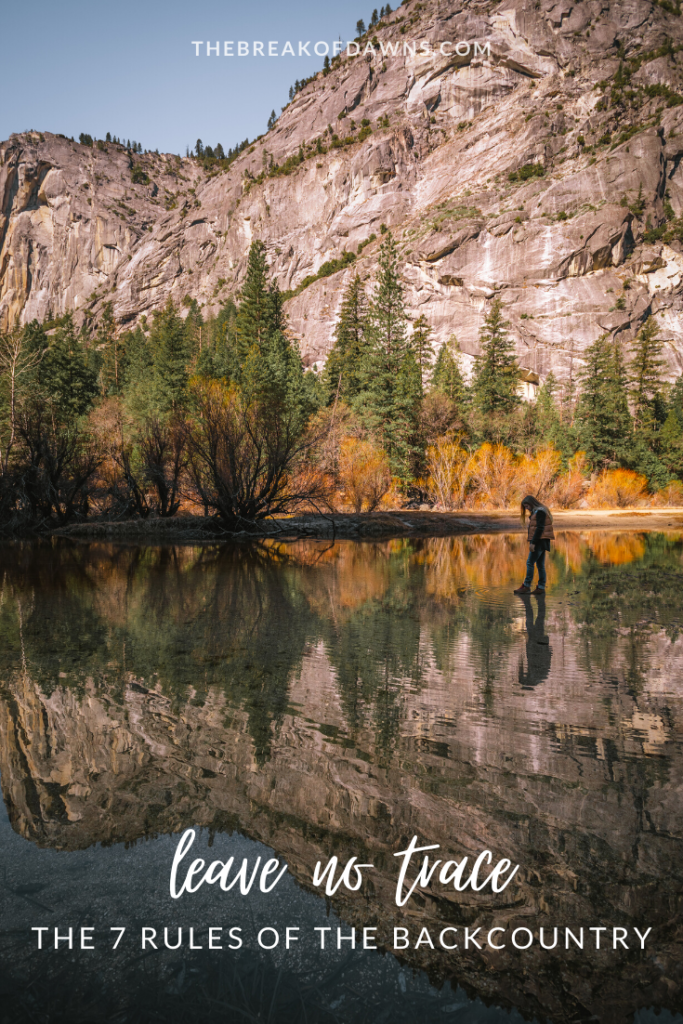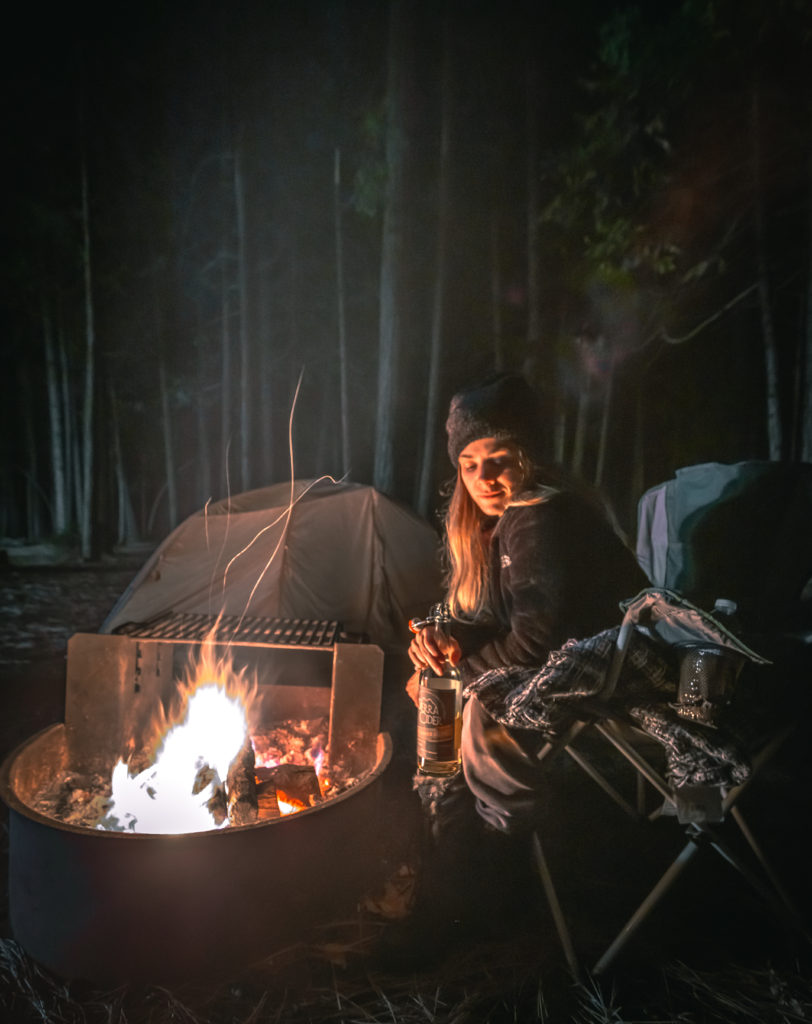
Nature is where I thrive the most and I couldn’t imagine living in a place where it wasn’t part of my life. I’m guessing you’re feeling that itch to get out into the wilderness too? Before embarking on your first backcountry hiking and camping trip, you should become familiar with Leave No Trace, the 7 rules of the backcountry. These statutes universally lay out the foundation for the ethical behavior in the outdoors.

Leave No Trace – The Rules of the Backcountry
‘Leave No Trace’ was established through a national education program in the ’90s by the U.S. Forest Service in collaboration with the National Outdoor Leadership School. It’s built upon 7 core principles with an “easily understood framework of minimum impact practices,” describing exactly how we can enjoy the outdoors responsibly.
For full information about Leave No Trace, visit The Leave No Trace Center for Outdoor Ethics

1. Plan Ahead & Prepare
There are multiple reasons why it’s important to plan ahead and prepare before embarking on a backcountry adventure. For most National Parks in the USA, having an exact itinerary in mind is necessary to snag a permit. This will not only help you plan for the conditions of where you’re going but also aid in minimizing the impact on the land.
Preparations are pertinent while out in the backcountry, especially at high elevations where the elements can change in an instant. While in the North Cascades, we were hiking in 80 degree weather but at the summit temps dropped nearly 30 degrees. Preparing for the backcountry and having a plan will allow you to decide how much food and propane to bring, what type of extra clothing you’ll need and the gear to help you survive, only creating a more enjoyable backcountry experience.

2. Travel and Camp on Durable Surfaces
The main tip while traveling in the backcountry is to stay on trail! Due to people constantly trekking off trail, the amount of demolished vegetation I have seen on my time in the backcountry is appalling and can lead to scarring that can last for years. Some trails may not be as apparent and you could be forced to complete scramble routes. If this happens, do your best to avoid stepping on plants and flowers.
While most National Parks have designated backcountry sites, some parks (like Yellowstone for example) only specifies where you cannot camp so you’re free to choose a spot on your own. It’s important to stay at least 1/4 mile away from any water source to not disturb wildlife and to ensure you’re not contaminating that source. Try and pick camp areas where less vegetation exists to not disturb the soil. Once you’re done camping, do your best to clean up the site by raking out footprints with a stick and spreading out downed limbs and brush to allow the vegetation to regroup.


3. Dispose of Waste Properly
Possibly one of the most important parts of the backcountry is this mantra: “Pack out what you pack in!” This goes for food, toilet paper, packaging and even feminine products.
Food waste — I only ever pack lightweight items like tuna bags over tuna cans and oatmeal paper containers over the plastic containers. I bring snacks in ziploc bags and use those for excess trash. When cooking meals, I only ever whip up what I know I’ll eat to ensure I don’t have any leftovers. I wash my dishes by putting a little water into a bowl and then use paper towels to wipe them clean.

What about human waste? Have you ever done your business outside in a hole? Well, if you’re planning to backpack chances are you’ll get to experience it. While some backcountry sites have pit toilets to use, you must still pack out any toilet paper or feminine products. If a pit toilet doesn’t exist, be sure you’re at least 70 adult steps away from any water source, trail or campsite. Dig a cat hole 6-8 inches deep and get to doin’ the biz. Bring a trash bag with you to place your toilet paper in, ensure the waste is buried when you’re done and place some rock or brush over the pile. For urinating, try to do so on a hard surface as animals can smell the salts and may begin digging up the vegetation to get to the urine.
4. Leave What You Find
Federal Law prohibits any natural objects to be removed from federally-protected land like forests and parks. Sticks, limbs, leaves and other vegetation may be placed in a spot by an animal who plans to come back for it later. We have to remember that we are traveling by foot in their world, so it’s important to respect them in that notion.
‘Leave What You Find’ also pertains to campsites. Resist using hammers or nails to hang things and never cut down or hack at a tree for any reason. For campfires, only use the dead limbs you find on the ground and don’t move the campfire rings.

5. Minimize Campfire Impacts
If you’re traveling in the backcountry in a National Park or Forest, you should already be knowledgeable about whether or not campfires are permitted at your camp. Unsure of the regulations? Analyze the conditions of the ground around you. Unfortunately, in most backcountry locations during summer, campfires are prohibited to reduce the risk of wildfires.
The most optimal place to have a campfire is within an existing fire ring. Once again, only use the dead and down limbed as wood for your fire and remember that you must extinguish your fire with water. Never walk away from a fire unattended and always ensure it is dead out when you leave it.

6. Respect Wildlife
As I said before, we are traveling through the home of the wildlife. It’s pertinent that we respect it and keep it as a place where they can live safely and happily. Never approach an animal in the backcountry, keep your distance and make little to no noise so you don’t scare them (the exception is in bear country where some noise is necessary to not startle them, allowing them to keep their distance.)
Be sure that you’re not contaminating or harming the water sources as this is the animal’s only means for drinking. If swimming in ponds or lakes, keep the water clean by never using soap or perfumed/oily products.

7. Be Considerate of Other Visitors
A ranger in the North Cascades once told me this was the ultimate rule above all the others because if we’re being considerate of others, all the other 6 rules fall into place.
We have to remember that every one wants to experience the backcountry in different ways. Some may want to constantly snap photos on their cameras (ehem… me!), some may want to play music or some may throw all technology aside to get lost within nature. Whatever the inspiration in the backcountry is, we all must act in a way that respects everyone else around us. That notion applies to the hikers around us currently but also to those who may be visiting in the future. After all, that’s the goal of the Leave No Trace rules, to allow others to experience a place like we have.
Reference: © 1999 by the Leave No Trace Center for Outdoor Ethics: www.LNT.org.
Read More Nature Travel Posts HereLike this Post? Pin It!




| This post contains affiliate links which means that, at no extra cost to you, if you purchase one of these products I may receive a small commission. This helps me maintain my blog as a free space to you. Check out my Disclaimer for more info.


Thanks for sharing all these tips! I would love to spend a few days in the back country 🙂 Your pictures are insanely beautifuL!
Thanks for checking them out! You’d have so much fun in the backcountry completely switching off from everything; such a freeing feeling!